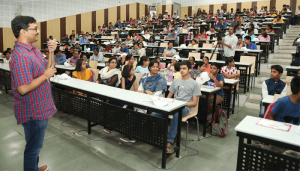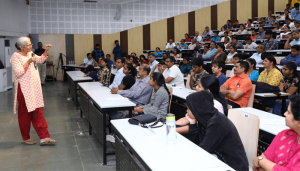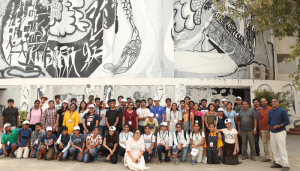“From tomorrow, the average age of the institute will go up by 10 years,” said Prof. P. J. Narayanan, Director of IIIT-H, a tad wistfully. He was speaking at the concluding ceremony of the annual outreach activity that the institute undertakes especially for school-going children – the Student Technology Education Program (STEP). Visitors to the campus during the 3-week period could be forgiven for mistaking it to be a school going by the lively atmosphere and the medley of young voices in the corridors. But behind all the fun and frolic lies the core philosophy of the institute: a deeper social objective. Read on.

Enabling Young Minds
When IIIT-H set up its Outreach division in 2004, it was in line with its mission of strengthening its initiatives in the areas of IT education, research and cultivating IT awareness for industry and society. The faculty believes that as an institute wherever possible, as a general sense of social duty, a connection ought to be made. So apart from working with industry, there’s a second level of outreach more directly related to capacity building. Here, the institute engages with other engineering colleges and research institutions and assists them in areas that they themselves are doing well in, faculty development and so on. But why the foray into early childhood education? As a natural extension to the existing mandates, the institute turned its focus towards younger children. “We got thinking about what we can do for schools within our realm. Can we introduce computational thinking to school kids? It’s more of a social initiative than anything else. It’s not going to help us in any way. But as a research-based educational institution, it seemed like something worth trying. And that’s how the STEP program started”, says Prof. Ramesh Loganathan, Professor and Dean, Co-Innovation.

Approach To Problems
Way back in 2014, the IIIT-H think tank believed that in an increasingly gadget-driven, IT-enabled world, it was imperative to align thought processes such that fundamental computational thinking and problem solving skills became a part of early education curriculum. With this in mind, the institute rolled out the STEP program with a strong focus on computational thinking that aimed to spread the concept to a larger community. To explain computational thinking, it is a sort of thinking process where first one breaks down a complex problem into smaller manageable parts (Decomposition), looks at each part closely and tries to figure out how such similar problems have been dealt with in the past (Pattern recognition), focusing only on the relevant while ignoring the irrelevant (Abstraction), and finally formulating simple rules of logic to solve each of the smaller problems (Algorithms). The program so far has been split into two tracks, one for middle school students (Grade 7-8) and another for high school students (Grade 9-10). Labelled Computational Thinking and Applications, and Computational Thinking and Problem Solving respectively, they are introductory and exploratory in nature about how computational thinking can be applied to solving problems.

No Code OK Please
Over a period of 3 weeks, faculty members and other experts talk about computational thinking in various areas of everyday life such as art, music, maths, and others. Contrary to popular perception, this program is not a programming course, “The curriculum is designed to enable young minds to build logical thinking, problem solving and analytical skills through theoretical as well as hands-on sessions. Our version of computational thinking does not involve any programming. So this is not an early entry to Java or C!”, clarified Prof. P. J. Narayanan. And if one thought it would be apt only for those desirous of pursuing a career in Computer Science, he continued by saying,“These programmes were based on the premise that whichever career the student chooses to pursue later in life, computational thinking will be an essential element.”
Dance Like An Algorithm
In its sixth edition of the summer program, the curriculum underwent a revamp. Prof. RaviKiran Sarvadevabhatla, STEP coordinator this year says that he looked at resources online to keep the syllabus contemporary. “The syllabi for Computational Thinking didn’t originate in IIIT-H. It’s been there for a while. There were activities online for different age groups, some of which required the usage of a computer and some of which did not. I picked the ones that did not require a computer. I also came across a bunch of videos where algorithms were presented in dance form,” he says. It definitely upped the coolness quotient and made the entire experience fun for the students. There was even a competition where the prize-winning team that choreographed a dance number to check whether a given word string was a palindrome or not, performed on the concluding day. An important aspect of the summer program was the intended level of interactions and group discussions. “Typically school syllabi structure is not geared towards these two things. Real life and even undergraduate education involves working in teams. We wanted to give a flavour of what it means to come up with an answer in groups,” explains Prof. Sarvadevabhatla.

A is for AI
Artificial Intelligence was also a new addition to this year’s curriculum. Broadly titled “Computational Thinking and AI”, it introduced the children to the term that is used everywhere. “AI is a buzzword and it’s important for children to understand what it means in an honest manner – without hype. They should be excited about its possibilities but also understand its limitations,” says Prof. Sarvadevabhatla. With IIIT-H being perfectly placed for an early introduction to AI, there were lectures from expert professors working in related areas of AI. For Prof. Sarvadevabhatla, it was heartening to see that when presented with an opportunity, the children later applied these concepts in activities, like when they had to design a fun game that could be played. One of the prize-winning entries came from a child who used ‘divide and conquer’ to come up with a dictionary-based game. “Outcomes like these are extremely satisfying,” he recounts. Programming per se was not left out completely though. CodeChef was included for some of the sessions (for older kids). “But we tried to keep it to a minimum,” says Prof. Sarvadevabhatla.

Seeking Impact
Speaking of the program, Prof. P. J. Narayanan says that the success of this School Outreach Activity is visible with some of the former students not only performing very well but some of them also qualifying for the National Olympiads. Nevertheless a change was due in the program’s curriculum. And there were fundamentally two dimensions to it. One, was the inclusion of AI to it. And the other was working on taking this in the coming years to a few Jawahar Navodaya Vidyalayas and later to Telangana government schools. “When the STEP program was kickstarted, it went off well the first year. Most people seemed to like it, and it was well received by parents and children alike. But from the second year onwards, the question arose about impact, ” says Prof. Loganathan. With children from affluent schools (who could afford to conduct such camps themselves) attending the program, the merits of such a program came under a cloud. Without explicitly modeling itself that way, the STEP program has been on the lines of an initiative called AI4ALL, a US-based non-profit that aims to create more access for underrepresented people in the field of artificial intelligence. Without any formal label, most of what was taught as part of the Computational Thinking course at IIIT-H was essentially the foundation of AI. “We added a few modules of AI to it this year and tweaked the program,” says Prof. Loganathan. “The AI4ALL is a common structure that many of the leading US universities follow, from Stanford to UC Berkeley to CMU. Many of them conduct a summer program for high schoolers. Their purpose is different though – they want to create excitement around AI so that when they join college, they will consider AI or Computer Science programs. Our objective was different but the structure was very similar,” says Prof. Loganathan. While the course content may be at the heart of AI, the institute believes that they are also generic life skills that can come in handy in Business, Commerce, Life Sciences and so on.The idea has been to change the thought process at the grassroot level. Incidentally, as part of its National Strategy for Artificial Intelligence, NITI Aayog, the Government of India’s policy think tank plans on formulating a curriculum for school children with AI in it.

Next STEPS
While the immediate course of action is not set in stone yet, the decision has been made to pilot the curriculum at the Navodaya school in Gopanapally, Hyderabad first. “One thought for next year is to get half the children from conventional schools like every year and the other half from the socially weaker sections. The other thought is to just do a teacher-training program for the teachers of Navodaya schools which would perhaps be a more scalable model. The idea is to structure it as a year-long or two-year-long co-curricular program in their premises, run by their teachers. We want to start with Navodaya schools and the hope is that we can expand to other government schools later. The endeavour is to go beyond core engineering education,” says Prof. Loganathan.



